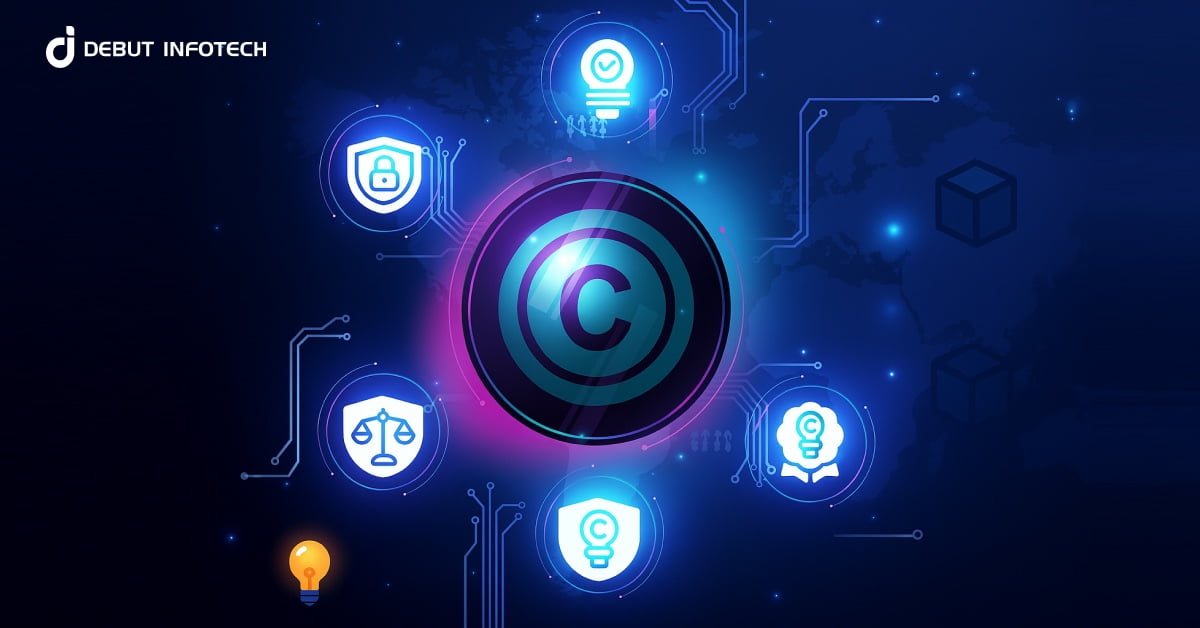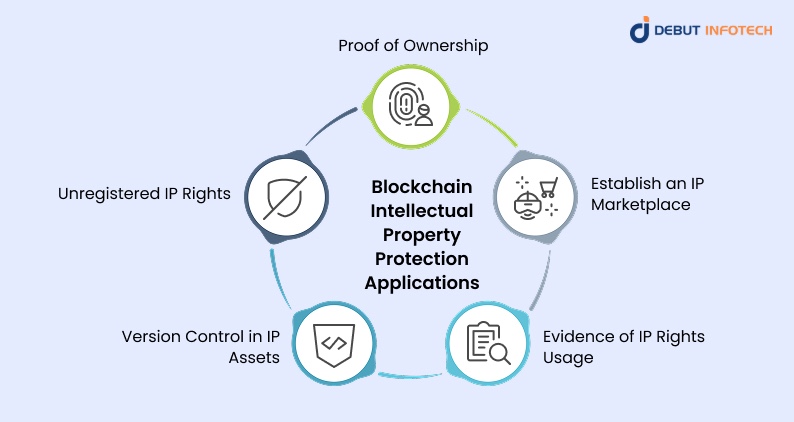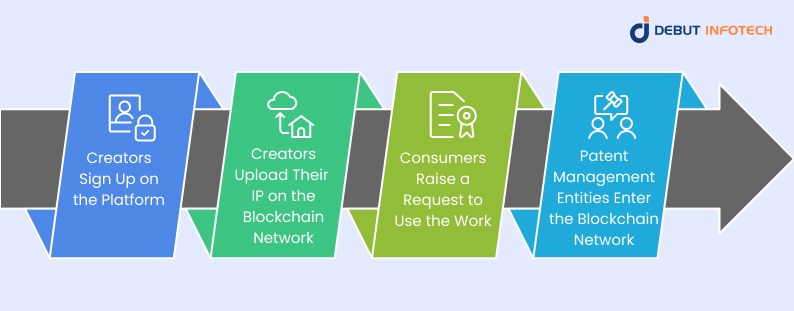Table of Contents
Home / Blog /
Blockchain Intellectual Property Protection for Creators & Businesses
July 18, 2025

July 18, 2025
Blockchain intellectual property protection is transforming how creators secure and manage their rights. According to Deloitte’s Global Blockchain Survey, nearly 80% of executives believe digital assets and blockchain will be critical to their industry within the next two years. Meanwhile, Digital TV Research estimates that revenues lost to online piracy nearly doubled to $51.6 billion between 2016 and 2022, emphasising the urgent need for tamper-proof protection systems.
Blockchain’s decentralised ledgers, encryption, and consensus mechanisms create reliable and verifiable records of ownership and licensing. These tools already help inventors and creators protect their intellectual property across borders with greater confidence, efficiency, and transparency.
Understanding Blockchain Technology
Blockchain technology is a distributed digital ledger system that records transactions in a secure, transparent, and tamper-evident manner. By eliminating the need for centralised intermediaries, blockchain fosters a new paradigm of trust across industries. Each transaction, once verified and added to the chain, becomes part of a permanent and auditable history. This foundational design has established blockchain as a powerful tool for industries that require robust verification, including finance, supply chain management, and intellectual property rights.
Key Features of Blockchain Technology
1. Decentralisation
Decentralisation is a cornerstone of blockchain. Instead of relying on a single controlling authority, data is shared across numerous nodes. This approach empowers participants with equal visibility and reduces the risk of tampering or unilateral control. For innovators protecting intellectual property, decentralisation ensures that no single entity can alter ownership records without collective validation.
2. Distributed Ledgers
Distributed ledgers are synchronised databases replicated across all nodes of the network. Every participant holds an identical copy of the ledger, which promotes transparency and accountability. In the context of IP rights, this shared visibility supports clear, traceable records of ownership and licensing agreements.
3. Consensus Mechanisms
Consensus mechanisms, such as Proof of Work or Proof of Stake, are protocols that facilitate agreement among participants on the validity of transactions. These mechanisms are evolving rapidly, paving the way for faster, greener, and more adaptable blockchain solutions that can scale in tandem with the growing needs of global IP management.
4. Immutability of Records
Once data is recorded in a blockchain ledger, it becomes immutable. Altering any block requires consensus across the network, rendering unauthorised modifications virtually impossible. This blockchain for IP characteristics offers IP holders a dependable foundation for asserting ownership claims.
5. Encryption
Encryption safeguards the confidentiality of transactions and sensitive data within the blockchain. Through advanced cryptographic methods, blockchain platforms can secure IP assets while maintaining controlled access, ensuring that proprietary information remains protected.
Ready to turn these core blockchain features into real business results?
Our team designs and delivers secure, scalable platforms that fit your goals and grow with you—helping you move faster and stay ahead.
How Blockchain Can Help the Intellectual Property Rights Industry
1. Ideas Generation
Blockchain in intellectual property empowers innovators to record their ideas securely the moment they are conceived. By creating a verifiable, time-stamped record on a distributed ledger, creators can prove the originality of their concepts. This fosters an environment where collaborative brainstorming can flourish, while reducing the risks of theft or disputes about who generated an idea first.
2. Ownership and Licensing
The process of establishing and managing IP ownership becomes far more efficient with blockchain. Smart contracts can automate licensing agreements, monitor usage, and enforce payment terms transparently, ensuring compliance and efficiency. This not only reduces administrative overhead but also ensures that all stakeholders have an immutable record of ownership transfers, agreements, and royalties at every stage of business of blockchain.
3. IP Transactions
Blockchain records every transaction related to intellectual property in a permanent and auditable ledger. Whether it’s selling, licensing, or pledging IP as collateral, each action is securely documented. This comprehensive visibility reduces the likelihood of disputes, simplifies compliance checks, and builds trust between creators, consumers, and regulators worldwide.
What is Blockchain Intellectual Property Protection?
Blockchain intellectual property protection refers to using distributed ledger technologies to document, verify, and enforce rights over creative and innovative works. This practice integrates smart contracts, encryption, and consensus protocols to preserve the integrity of IP records.
Organisations benefit from greater operational efficiency and heightened assurance that their assets are adequately safeguarded.
Blockchain Intellectual Property Protection Applications

1. Proof of Ownership
When a creator registers their work on the blockchain, it generates a unique digital fingerprint and an incorruptible timestamp proving ownership. This immutable record can be used in legal settings to defend against infringement claims. Such proof is particularly valuable in fast-moving markets where demonstrating priority of creation is essential.
2. Establish an IP Marketplace
Blockchain-based marketplaces enable creators to list their intellectual property assets for sale or license globally. Smart contracts automate negotiations, payments, and the transfer of rights, reducing delays and costs. This decentralised approach encourages broader participation from small inventors and artists who previously lacked access to international distribution channels.
3. Evidence of IP Rights Usage
Every time an IP asset is used, whether for licensing, adaptation, or publication, the blockchain automatically logs the transaction. This creates a reliable, tamper-proof record of usage that supports royalty claims and demonstrates compliance. Such evidence streamlines enforcement and provides clarity in the event of contractual disagreements.
4. Version Control in IP Assets
Blockchain can record every iteration of an intellectual property asset, capturing updates and revisions over time. Each version is linked to its predecessor, providing a clear history of how a work evolved. This granular visibility protects creators and simplifies collaboration by ensuring that all stakeholders reference the correct version.
5. Unregistered IP Rights
Even without formal registration, creators can secure evidence of their work’s existence and authorship by recording it on blockchain. This early documentation establishes a protective timestamp and serves as preliminary proof of ownership. It reassures innovators that their ideas are safeguarded while they navigate formal IP registration procedures.
Users of Blockchain Intellectual Property Protection
1. Patent Creators
Inventors and artists rely on blockchain to secure their creations, record transactions, and facilitate licensing arrangements. The technology reduces barriers for small innovators who lack extensive legal resources.
2. Patent Consumers
Businesses and investors who acquire or license IP benefit from transparent histories and verifiable ownership. Blockchain helps them avoid infringements and streamline their procurement processes.
3. Copyright Managing Entities
Organisations tasked with monitoring and enforcing copyright can integrate blockchain into their workflows. This blockchain integration enhances detection of unauthorised use and automates royalty collection, improving efficiency.
How Does a Platform Around Blockchain Technology Patents Work?

Here’s how blockchain for patents functions:
Step 1: Creators Sign Up on the Platform
Inventors start by creating a secure account on the blockchain-enabled platform, providing verified identity details. This registration process ensures that only authenticated users can submit and manage intellectual property assets, reducing fraud risk and strengthening trust across the ecosystem of creators, consumers, and regulators.
Step 2: Creators Upload Their IP on the Blockchain Network
After registration, creators upload their patents or copyrighted works. The platform generates a cryptographic hash and a timestamp, which serve as unique identifiers. This process ensures the asset is permanently recorded on the ledger, creating immutable proof of the work’s existence and the creator’s claim to ownership.
Step 3: Consumers Raise a Request to Use the Work
Potential licensees or buyers search the platform for IP assets that fit their needs. They submit requests to access or license specific works. Smart contracts then define the terms of use, including pricing and duration, automatically enforcing agreements when conditions are met and payments are confirmed.
Step 4: Patent Management Entities Enter the Blockchain Network
Authorised patent offices or regulatory bodies join the network to oversee and validate transactions. These entities can verify ownership records, monitor licensing activities, and mediate disputes as needed. Their participation enhances trust, establishes compliance with regional laws, and ensures smooth operation across the ecosystem.
Design Choices for Blockchain-Based Intellectual Property Systems
1. What Type of Blockchain Should Be Implemented?
Organisations must weigh the benefits of different types of blockchains, including public, private, and consortium blockchains. Public ledgers offer transparency but may lack privacy, while private networks ensure confidentiality with tighter control. Consortium blockchains blend both approaches, providing shared governance among selected participants who jointly validate transactions and oversee system integrity.
2. Which Blockchain Platform Should Be Used?
Selecting an appropriate platform depends on technical needs, scalability, and smart contract capabilities. Ethereum offers robust smart contract tools, Hyperledger provides modular frameworks for enterprise use, and Corda focuses on financial agreements. The choice should align with data security, regulatory, and performance requirements of the intended application.
3. Where Should the Data Be Stored?
Developers must decide whether to keep records on-chain or off-chain. On-chain storage guarantees immutability but can be costly and less scalable. Off-chain storage stores large files elsewhere, recording only hashes on the blockchain, thereby preserving efficiency and confidentiality while maintaining verifiable links to the protected data. If you’re unsure, you can reach out to experienced blockchain consultants for support.
4. What Data Needs to Be Stored?
Key data points often include ownership details, timestamps, licensing terms, and usage records. Carefully defining this scope is crucial to ensure compliance and protect sensitive information. Well-structured data models help strike a balance between transparency and privacy, enabling creators and consumers to validate claims while safeguarding proprietary content.
Real-World Examples of Companies Using Blockchain to Protect Intellectual Property
1. Mediachain Lab
Mediachain Lab developed an open protocol to track creative works and their attribution. By recording metadata on blockchain, the platform improved licensing transparency. Spotify acquired Mediachain in 2017, with the intention of integrating these capabilities to help musicians claim credit and receive fair compensation for their contributions worldwide.
2. Blockai
Blockai provided a simple platform for artists to register their creations. Each work received a blockchain timestamp proving ownership. The system generated certificates that creators could use in infringement disputes, providing independent artists with a cost-effective way to protect their work and assert their rights without complex legal processes.
3. Ujo Music
Ujo Music built a blockchain-powered platform where musicians publish music, set licensing terms, and receive royalties automatically. By utilising smart contracts, Ujo ensured transparent and instant payments. The platform empowered artists with direct control over distribution, reducing reliance on traditional intermediaries and streamlining global licensing workflows.
4. Verisart
Verisart combines blockchain with certification services to authenticate artwork and collectables. The platform creates tamper-proof records of provenance, enhancing buyer confidence. Galleries and creators use Verisart’s certificates to prove authenticity and ownership. At the same time, collectors gain an immutable, verifiable history for every registered piece in their collections.
5. Bernstein
Bernstein helps innovators secure IP assets through blockchain timestamping. Its tools allow users to document inventions and create audit trails. This process establishes legal proof of existence and ownership, supporting patent applications and disputes. Bernstein’s services appeal to businesses seeking transparent, secure records of their intellectual property.
Challenges and Recommendations for Blockchain Intellectual Property Protection
1. Accessibility
Many creators lack the technical knowledge or resources to use blockchain platforms effectively. Small businesses and individual artists may find registration processes complicated, creating barriers to entry. This digital divide can limit widespread adoption and undermine the technology’s inclusive potential in protecting IP rights.
Recommendations
Develop intuitive user interfaces and offer training programs to make blockchain tools accessible. Governments and industry associations should sponsor outreach initiatives, ensuring that creators of all backgrounds understand how to register, manage, and enforce their intellectual property rights using blockchain technologies with confidence.
2. Regulatory Hurdles
Legal frameworks in many jurisdictions have not yet formally recognised blockchain records as admissible evidence. Conflicting regulations between countries create uncertainty, deterring companies and creators from investing in blockchain solutions due to unclear compliance requirements and possible legal disputes over jurisdiction.
Recommendations
Regulators should establish clear standards for blockchain-based records and harmonise cross-border rules. Collaborative working groups can develop frameworks to ensure that blockchain registrations are enforceable globally, providing creators and businesses with legal clarity and confidence when using distributed ledgers to prove ownership and manage licensing.
3. Scalability
Public blockchains often struggle to handle large transaction volumes, resulting in slower processing times and higher fees. As more IP assets are registered and exchanged, these scalability limitations could lead to delays, erode user trust, and create bottlenecks in verification and licensing workflows.
Recommendations
Implement Layer-2 scaling solutions or hybrid architectures that combine public and private blockchains. These approaches can enhance transaction speeds and reduce costs while maintaining security and transparency. Investing in scalable infrastructure ensures that platforms can grow with the rising demand for blockchain IP protection services.
4. Interoperability Issues
Different blockchain platforms often operate in isolation, using incompatible protocols and data formats. This lack of interoperability makes it difficult to share or verify IP records across systems, reducing the effectiveness of blockchain in global intellectual property management and enforcement contexts.
Recommendations
Adopt common data standards and build APIs that allow blockchains to communicate seamlessly. Encouraging industry alliances to promote interoperability can create a more cohesive ecosystem where IP records can be validated and accessed across multiple platforms, fostering broader adoption and trust.
5. Data Privacy
Storing sensitive ownership details and licensing agreements on a public ledger raises concerns about data privacy and confidentiality. Unauthorised access to proprietary information could harm creators’ interests, deter adoption, and potentially breach data protection laws in different jurisdictions.
Recommendations
Utilise encryption, permissioned networks, and selective disclosure techniques to safeguard sensitive data. Systems should grant creators control over who can access their records while preserving the integrity of timestamps and ownership proofs. Privacy-preserving designs help strike a balance between transparency, regulatory compliance, and user trust.
Future of Blockchain Intellectual Property Protection
Looking ahead, blockchain is poised to redefine the IP landscape. As more industries adopt decentralised infrastructure, creators will gain unprecedented control over their works. Cross-border collaboration, automated licensing, and secure marketplaces will become standard practices, fostering innovation and economic growth on a global scale.
Ready to Safeguard Your IP?
Let’s build you a custom blockchain protection system that keeps your ideas safe and your royalties flowing.
Conclusion
Blockchain intellectual property protection provides a secure, transparent way for creators and businesses to manage and enforce rights.
As enterprise adoption rises, blockchain helps reduce IP disputes and administrative overhead by providing immutable records and automating smart contracts. While regulatory and technical challenges persist, solutions continue to evolve.
By embracing this technology, stakeholders across industries can protect their intellectual property more efficiently, foster global collaboration, and ensure rightful attribution and compensation in the digital age.
FAQs
A. Blockchain functions as a tamper-proof ledger, allowing you to record proof of your ideas, designs, or inventions. Once logged, the record’s timestamp can prove you owned the IP at that point. It essentially locks down evidence that nobody can quietly erase or alter.
A. It automates copyright tracking and payments. Creators register their work on the blockchain, which records ownership of the work. When someone buys or uses it, smart contracts trigger instant royalty payments. This eliminates intermediaries and helps ensure artists receive fair compensation without excessive paperwork.
A. Blockchain can record ownership and automate licensing deals. But it can’t stop people from copying or distributing files illegally outside the network. So, it’s great for proof and payments, but enforcement still relies on traditional legal systems and takedown requests.
A. More creators and companies are likely to adopt blockchain to secure ownership, track usage, and automate royalties. Expect better standards and global recognition. Still, laws and courts must evolve alongside it, so it’s not a magic fix for every infringement issue.
A. They’re mainly classified as digital records proving ownership or rights to creative works. The blockchain itself doesn’t grant legal rights but provides evidence. So, you’d still register copyrights officially, while the blockchain acts as extra backup to prove when you created something.
Talk With Our Expert
USA
2102 Linden LN, Palatine, IL 60067
+1-708-515-4004
info@debutinfotech.com
UK
Debut Infotech Pvt Ltd
7 Pound Close, Yarnton, Oxfordshire, OX51QG
+44-770-304-0079
info@debutinfotech.com
Canada
Debut Infotech Pvt Ltd
326 Parkvale Drive, Kitchener, ON N2R1Y7
+1-708-515-4004
info@debutinfotech.com
INDIA
Debut Infotech Pvt Ltd
Sector 101-A, Plot No: I-42, IT City Rd, JLPL Industrial Area, Mohali, PB 140306
9888402396
info@debutinfotech.com




Leave a Comment